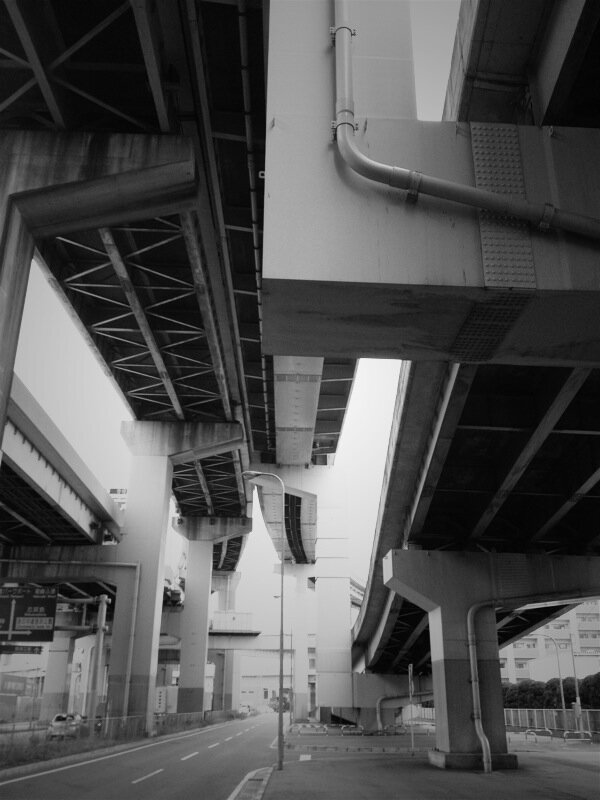Back when I did a lot of translation work, there was a phrase that I was forced time and again to render into English: utsukushii shizen ni megumareta (美しい自然に恵まれた, lit. “blessed with beautiful nature”). I would translate it in a variety of ways, such as “The prefecture is blessed with bountiful nature”, “The city is surrounded by lots of natural beauty”, or “The town is surrounded by beautiful nature.” Or even, “It is located in an idyllic natural setting.” I found that if I took too much poetic license in my translations, they invariably came back to me with “You left out ‘beautiful’” or “You failed to mention ‘nature’ in your translation”. Whatever.
The thing that killed me when I was doing these translations is that I would look out my window at the jumble of telephone wires and cables, the lack of trees, the concrete poured over anything and everything that hadn’t been moving at the time, the gray balconies and staircases stretching as far as the eye could see and shout, “Where the hell is the ‘beautiful nature’? Tell me!! Where is it?!?!”
Having grown up in the west coast of the United States, I know what unspoilt nature is supposed to look like. In my twenty years in Japan, however, I have yet to find a place that has not been touched by the destructive hand of man despite having seen quite a bit of the country. Mountains that have stood since time immemorial are now “reinforced” with an ugly layer of concrete; rivers and creeks are little more than concrete sluices; and Japan’s once beautiful coastline is an unsightly jumble of tetrapods—concrete blocks resembling jacks—that are supposed to serve as breakwaters but do very little in reality.
The uglification of Japan has been well documented in Alex Kerr’s excellent and highly recommended books Lost Japan and Dogs and Demons.
"Today's earthworks use concrete in myriad inventive forms: slabs, steps, bars, bricks, tubes, spikes, blocks, square and cross-shaped buttresses, protruding nipples, lattices, hexagons, serpentine walls topped by iron fences, and wire nets," he writes in Dogs and Demons.
"Tetrapod may be an unfamiliar word to readers who have not visited Japan and seen them lined up by the hundreds along bays and beaches. They look like oversized jacks with four concrete legs, some weighing as much as 50 tons. Tetrapods, which are supposed to retard beach erosion, are big business. So profitable are they to bureaucrats that three different ministries — of Transport, of Agriculture, Forestry and Fisheries, and of Construction — annually spend 500 billion yen each, sprinkling tetrapods along the coast, like three giants throwing jacks, with the shore as their playing board.
These projects are mostly unnecessary or worse than unnecessary. It turns out that wave action on tetrapods wears the sand away faster and causes greater erosion than would be the case if the beaches had been left alone."†
One of Japan’s recurring problems is that once something has been set into motion it is often difficult to change course. As a result, by the early 90s more than half of Japan’s coastline had already been blighted by these ugly tetrapods. I dread to know what the figure is today.
One of first of my imaginary political party’s[1] campaign promises is to form a Ministry of De-construction that would remove unnecessary dams, tetrapods, concrete reinforcements, and so on. The idea is to put the ever so important general construction industry to work by undoing all of their mistakes. Second, where the dams, reinforcements and tetrapods were truly necessary, they would be concealed in such a way to look as natural as possible. Third, the electric cables would be buried. Fourth, there were would be stronger zoning and city planning to reign in urban and suburban sprawl. (Too late?) Create compact, highly dense cities that were separated from each other by areas of farming, natural reserves, and parks. (One thing I can’t get is how in a country with as large a population as Japan’s and land as limited put vertical limits on construction—Fukuoka City once had a limit of 15 stories). Fifth, reintroduce diversity to the nation’s forests. No more rows upon rows of cedar that not only look ugly, but give everyone hay fever in the spring.
Unfortunately, none of these things are bound to happen anytime soon. The Japanese are so accustomed to being told in speeches and pamphlets that their town or city is blessed with beautiful nature that they have come to believe it despite what they surely must see with their own eyes.
Familiarity sometimes breeds content.
[1] I call my party Nattoku Tô (なっとく党, The Party of Consent/Understanding/Reasonableness). It is a play on the sound of the local Hakata dialect and with the right intonation can me “You got that?” “Can you assent to that?”
†Kerr, Alex, Dogs and Demons: The Fall of Modern Japan, London: Penguin Books Ltd., 2001, p.289.




